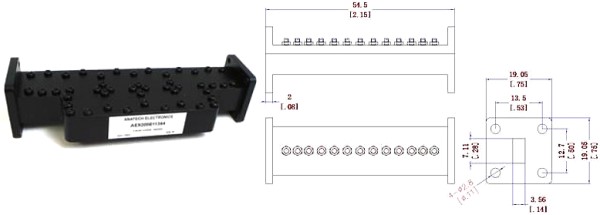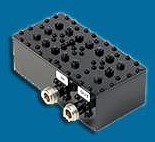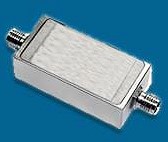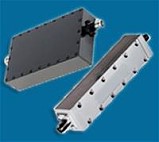
Press Release Archives:
2025 |
2024 |
2023 |
2022 |
2021
2020 |
2019
Content is copyright of company represented. Page format, custom text and
images are RF Cafe copyright - do not distribute. Note: Beginning
March 2025, posting of press releases will cost $100 each for non-advertisers.

Sam Benzacar of Anatech Electronics, an RF and microwave filter company, has published
his April 2021 newsletter that features his short op-ed entitled "A Wall of Interference!"
The allusion is to the "wall" of antennas that typically comprises cell tower installations.
Each antenna represents a source of potential signal interference for collocated
antennas' receivers whose connected front end low noise amplifiers must successfully
reject out-of-band signals and/or the inbound spurious mixer products generated
by out-of-band signals. Sam also presents some relevant industry news items as well.
A Word from Sam Benzacar
A Wall of Interference!
 By Sam Benzacar By Sam Benzacar
Co-sited wireless infrastructure is hardly new, but it has recently become extraordinarily
dense, thanks not just to 5G deployment but for increasing 4G LTE capacity as well.
Take a look at any tower, building, or other structure with cellular infrastructure
and you find a wall of antennas. This makes for a nightmare scenario for keeping
all the receivers they connect to free from the interference that can potentially
overdrive their first-stage low-noise amplifiers.
Of course, modern wireless networks employ a variety of techniques for dealing
with this problem, of which RF and microwave filters both inside and outside of
the receiver are mandatory. Without a filter to attenuate signals other than the
desired ones, the LNA ingests both in-band and out-of-band signals, likely saturating
it and in the worst cases destroying it. Even out-of-band signals that should, theoretically,
be lower in amplitude than those in the band, when mixed with the desired signals,
create intermodulation products. It is a nasty problem, and it is going to get worse
as more channels are added in the mid-band spectrum.
Interestingly, while an LNA's stated noise figure may be very low, this "headline
spec" refers only to the device itself and not the system in which it is installed.
In reality, when the LNA is installed, the picture is very different: The receiver
becomes susceptible to in-band out-of-band RF interference and the data sheet spec
becomes almost irrelevant. Unless, of course, there is an RF filter installed prior
to it, which is why bandpass filters should the first line of defense in any system.
Amazingly, receivers in some systems (but not cellular networks) do not have pre-LNA
filtering. The "logic" here is that the user will probably install his own bandpass
filter, so leaving it out of the receiver lets them reduce its price. That is a
risky assumption.
Not surprisingly, solving co-site interference is one of the most frequent problems
Anatech
Electronics has been solving in its 30-year history, from the early days when
towers were not highly populated with antennas to today's complex base stations
with multiple wireless carriers on the same tower along with public safety and other
services, operating from VHF to 3 GHz and recently up to 6 GHz (and soon to reach
higher).
The result of this work is a comprehensive library of filter designs that coverage
every band used by wireless, public safety, and Wi-Fi, with very high attention,
low insertion loss, and high Q. Our cavity filters deliver the highest rejection
in the industry with high power handling capability, and our notch filters eliminate
specific sources of interference. So, if you are faced with the increasingly challenging
problems caused by co-site interference, we certainly have the solution.
Below are some links to products that helps mitigate interference. Technically
RF filters are in most cases specifically designed to remove interference. May it
be from a co-site transmitter, Satellites, wireless communication site. May it be
the interferer, there always a solution, and they can also be customized to a specific
problem.
 AT&T Brings 5G to Public
Safety Network AT&T Brings 5G to Public
Safety Network
AT&T has begun to add 5G capability to FirstNet by upgrading the dedicated
FirstNet network core. First responders in Houston have been taking part in a 5G
trial and parts of 38 cities and more than 20 venues will gain access to AT&T
millimeter-wave spectrum. They will also maintain access to AT&T's commercial
LTE spectrum bands. Houston and Cleveland are the first two cities to receive enhanced
encryption with nationwide completion by this time next year.
 5G Moves into the Edge 5G Moves into the Edge
Verizon Business and Amazon Web Services (AWS) are collaborating to deliver private
mobile 5G edge computing to enterprise customers. It will provide dedicated edge
compute infrastructure at the user location to enable low latency, higher levels
of security, and customization. Corning is the first company to employ these services,
integrating Verizon's private 5G networks and private edge platform with AWS Outposts,
a managed service that offers the same AWS infrastructure, services and tools to
any data center or facility, including factories, warehouses, and large business
campuses. The platform avoids requiring the customer to own extensive networking
and IT infrastructure.
 OTH Radars "Too Numerous
to Count" OTH Radars "Too Numerous
to Count"
According to the IARU Region 1 Monitoring System March newsletter, over-the-horizon
(OTH) radars make up about 60% of all interference, so many in fact that "one cannot
even count them anymore". There are a few stations transmitting on varying frequencies
as burst systems that transmit for only a few seconds then changing frequency. OTH
radar has been a headache for amateur radio operators for decades, and in the 7
MHz (40 m) band in particular play havoc with attempting to conduct even CW communications.
Now, they are apparently so numerous that even the best notch filters cannot get
rid of them. While Russia's systems have always been the biggest problem, China's
burst OTH system is the latest contributor, emitting sounds like a foghorn, according
to some irked listeners.
Getting Ready for 5G:
Anatech Electronics introduce New Ka band 30.5 GHz Waveguide Band Pass Filter.
Featuring a center frequency of 30.5 GHz, a bandwidth of 1000 MHz, an Insertion
Loss 1 dB Max, and a Power Handling is 20 watts.

Anatech Electronics Introduces a New Line of Suspended Stripline and
Waveguide Type RF Filters
Check out Our Filter Products



Cavity Band Pass Filters
LC Band Pass Filters Cavity Bandstop/Notch Filter
About Anatech Electronics
Anatech Electronics, Inc. (AEI) specializes in the design and manufacture of
standard and custom RF and microwave filters and other passive components and subsystems
employed in commercial, industrial, and aerospace and applications. Products are
available from an operating frequency range of 10 kHz to 30 GHz and include cavity,
ceramic, crystal, LC, and surface acoustic wave (SAW), as well as power combiners/dividers,
duplexers and diplexers, directional couplers, terminations, attenuators, circulators,
EMI filters, and lightning arrestors. The company's custom products and capabilities
are available at www.anatechelectronics.com.
Contact:
Anatech Electronics, Inc. 70 Outwater Lane Garfield, NJ 07026 (973)
772-4242
sales@anatechelectronics.com
Posted April 23, 2021
|








 By Sam Benzacar
By Sam Benzacar AT&T Brings 5G to Public
Safety Network
AT&T Brings 5G to Public
Safety Network  5G Moves into the Edge
5G Moves into the Edge OTH Radars "Too Numerous
to Count"
OTH Radars "Too Numerous
to Count"





